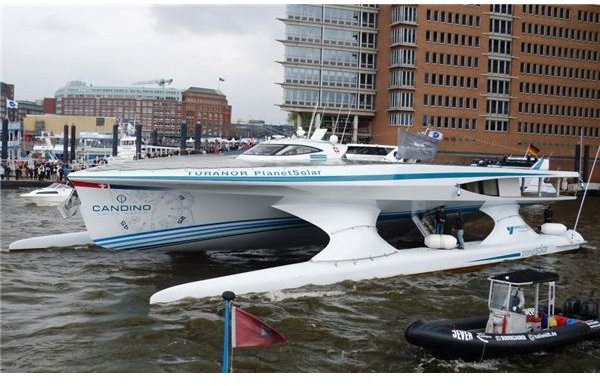Turanor - The World's Biggest Solar Powered Boat is Underway
Turanor - World’s Biggest Solar Powered Boat:
The Swiss company PlanetSolar has launched Turanor, a giant catamaran that runs entirely on solar energy. Turanor is claimed to be the biggest of its kind - the world’s biggest solar powered boat. PlanetSolar aims to show the world what Turanor can do, and in that process display the under-exploited potential of solar energy, by sending Turanor on a round the world journey. Turanor is the brainchild of Raphael Domjam, a former Swiss ambulance driver. The name “Turanor,” which means “Power of the Sun,” has been inspired from JRR Tolkein’s novel, Lord of the Rings.
Image Credit: Wikipedia
Turanor, The World’s Largest Solar Boat - Technical Details
The 85 ton multi-hull vessel, Turanor, measures 31 meters in length and is 15 meters wide. The solar powered boat is powered by 38,000 photovoltaic Cells (PVCs) that have been assembled into 825 bigger modules. Under stormy conditions, the solar arrays attached to the side riggers and rear wings can be retracted. The electrical energy output from these photovoltaic Cells is used to power four electric motors that produce a power output of 120 kW with 90% efficiency. The electric power thus produced is the source of power for all of the electrical and electronic appliances in the boat along with the twin carbon fiber propellers that allow the boat to be steered without rudders. A large lithium ion battery is used to store the solar energy, which is used to power the motors at nights or when the day is cloudy.
In the absence of sunlight, Turanor’s batteries allow it to run non-stop at 7.5 knots or 14 kilometres per hour (which is roughly the average speed of an average oil tanker) for three days. However, the makers of Turanor say that it can run for up to fifteen days, in the absence of sunlight, at lower speeds.
Turanor’s Journey
As the Turanor’s main source of energy is the sun, Turanor plans to follow the equatorial route so that it can take advantage of sunshine and thereby complete the round the world trip in the shortest possible time. The 34,000 mile journey is scheduled over a period of 160 days. The start and finish points are both at Monaco and the planned pit stops are Miami, Cancun, and San Francisco in the US; Sydney, Australia; Singapore and Abu Dhabi, Asia.
Although the 16 million pounds money spent in the construction of Turanor might attract attention from people around the to the under-exploited potential of solar energy and how it can be used in the transportation sector (and many sectors for that matter), there are many who would have been benefited from this huge sum of money. For instance, solar villages could have been constructed or they could have been installed in some developing city or something that would have been useful for people in remote areas with little or no electricity.
Links for Further Reading:
